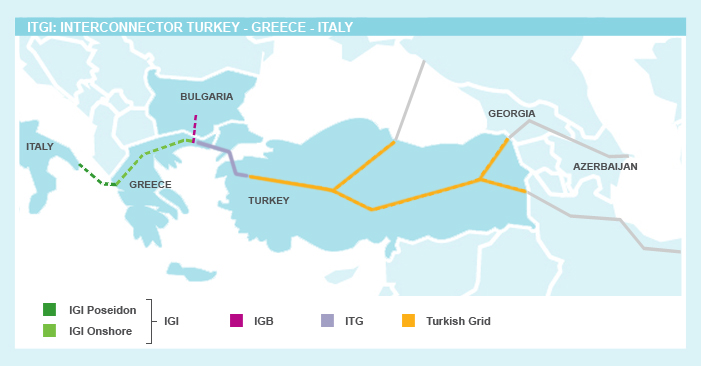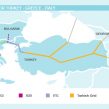
Gazprom Promotes Greece–Italy Transit Route to Obstruct European Corridor
Publication: Eurasia Daily Monitor Volume: 13 Issue: 43
By:

On February 24, in Rome, the chief executives of Russian Gazprom, Italian Edison (electricity conglomerate, 99 percent owned by Électricité de France) and Greek DEPA (national pipeline operator and gas trader) signed a memorandum of understanding to develop a pipeline route from Greece to Italy for Russian gas.
Edison and DEPA are parity owners of the Interconnector Turkey–Greece–Italy (ITGI-Poseidon). This is a suspended project that lost out in the commercial competition over transportation of Azerbaijani gas within the European Union–backed Southern Gas Corridor (SGC) to Europe. Four years after that loss, these same ITGI shareholders are switching sides to Russia. The route of ITGI-Poseidon runs, east–west, all across Greece and along the seabed of the Ionian Sea to Italy. This project could serve as a basis of discussions to develop that pipeline route for Russian gas.
Such a project could undermine the Southern Gas Corridor to Europe by preempting or blocking the route and the market of Azerbaijani gas. The Trans-Adriatic Pipeline (TAP project), a component of the Southern Corridor to Europe, is planned to carry Azerbaijani gas via the Balkans to Italy. Rivaling this, Gazprom proposes working with Edison and DEPA to further develop ITGI-Poseidon (Joint press release, Gazprom.com, February 24).
Gazprom CEO Alexei Miller reported this initiative to President Vladimir Putin on Russian television, on February 29. Their choreographed appearance was timed to a high-level SGC strategy meeting held that same day in Baku (see below). Miller explained that this initiative would basically revive the ITGI-Poseidon. Originally designed to carry Azerbaijani gas to Europe, as Miller reported to Putin, the ITGI could henceforth be dedicated to Russian gas (Kremlin.ru, February 29).
The timing of the Gazprom-Edison-DEPA announcement seemed calculated as a shot across the SGC’s bow. It came five days ahead of the Southern Corridor Advisory Council’s meeting with the European Commission, on February 29, in Baku (Trend, February 29–March 2). And the Kremlin showed Putin’s nod to Miller’s initiative on the very day of the Baku meeting.
Under their memorandum of understanding, Gazprom, with Edison and DEPA, shall cooperate to organize gas deliveries through the “southern route for Russian gas supplies to Europe” (standard designation of the westbound branch of Gazprom’s South Stream project, currently suspended). They would create a dedicated pipeline route, “taking full advantage” of studies already conducted and permits obtained by ITGI-Poseidon along that route. The three signatories shall conduct a technical and economic feasibility study, to be completed by December 2016. The Russian gas flow would reach Greece via the Black Sea and unnamed “third countries” (i.e., Bulgaria and/or Turkey, both problematic).
At the signing event in Rome, CEOs Marc Benayoun of Edison and Theodoros Kitsakos of DEPA hailed Gazprom’s promise to enhance the roles of Italy and Greece as transit countries on the strength of Russian gas. Milller’s statement, moreover, spoke of gas supply and transit volumes “including Russian ones”—possibly an allusion to diverting Azerbaijani gas volumes from TAP (see above) by obstructing the latter. For its part, Greece hopes to add gas volumes later from the Eastern Mediterranean into the proposed transit route (EurActiv, February 26).
The proposed route would follow that of the ITGI-Poseidon pipeline project. This had originally been planned to carry 12 billion cubic meters (bcm) of Azerbaijani gas annually (see above). At present, ITGI’s shareholders, Edison and DEPA, propose to boost the project’s capacity to 20 bcm per year, equal to TAP’s maximum planned capacity (Natural Gas Europe, February 25).
ITGI’s route extends overland from the eastern border of Greece to the coast of the Ionian Sea, continuing with the Poseidon section on the seabed to Italy. This route, now tentatively envisaged for Russian gas, would run parallel to TAP’s route, both overland and on the seabed—except where TAP makes a detour from Greece into Albania to reach the sea coast. ITGI’s offshore extension, Poseidon, would cross the Otranto Strait (which separates the Ionian Sea from the Adriatic Sea) paralleling TAP’s Adriatic seabed route, and reaching an Italian landfall point near TAP’s landfall point (on the tip of the Italian boot’s heel) (see EDM, January 14, 2011; August 18, 19, 2011; January 6, 2012).
Geography and capacity make ITGI-Poseidon almost a mirror image of TAP, inherently a competitor to TAP downstream. This could potentially replay their intense competition upstream until 2012 over access to Azerbaijani gas, which TAP won. Greek governments have favored ITGI-Poseidon over TAP all along, not least because the Greek state is a major stakeholder in the former. Gazprom will undoubtedly use the memorandum of understanding just signed as a basis for promoting a Russian gas transit route and obstructing the European transit project via Greece to Italy.




